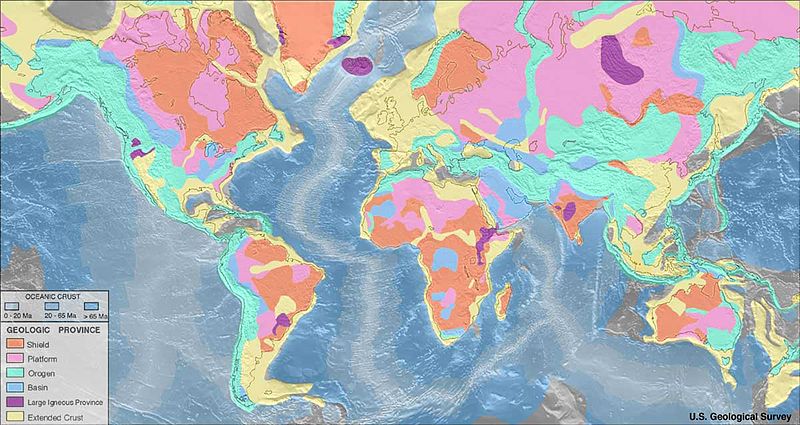|
metamorphic rock
|
A Craton is a stable part of the lithosphere which has
survived many cycles of continental rifting and collision and is typically
located in the interiors of a tectonic plate. Cratons are composed of ancient crystalline basement rock and have deep lithosphere
roots that may extend hundreds of kilometers into the earth’s mantle. A Craton
is also referred to as a shield, in which basement rock crops out at the
surface, or a platform, where basement rock is overlain by sedimentary rock. Examples of Cratons include the Wyoming Craton
(North America), the Amazonia Craton (South America), the Gawler Craton
(Australia) and the Kaapvaal Craton (South Africa).

Mantle tomography indicates that Cratons are underlain by anomalously cold mantle
corresponding to lithosphere more than twice the typical 100 km (60 mi)
thickness of mature oceanic or non- Cratonic continental lithosphere.At that depth, Craton roots extend into the asthenosphere. Craton lithosphere is distinctly different from
oceanic lithosphere because Cratons have a neutral or positive buoyancy and a
low intrinsic isopycnic density. This low density offsets density increases due
to geothermal
contraction and pr events the Craton from sinking into the deep
mantle. Cratonic lithosphere is much older than oceanic lithosphere—up to 4
billion years versus 180 million years.
The process by which
Cratons are formed from early rock is called Cratonization. The first large
Cratonic landmasses formed during the Archeaneon. During the Early Archean, Earth's heat flow was
nearly three times higher than it is today because of the greater concentration
of radioactive isotopes and the residual heat from the Earth's accretion. There was considerably greater tectonic and volcanic activity; the mantle was less viscous and the crust thinner. This resulted in
rapid formation ofoceanic
crustat ridges andhot
spots, and rapid recycling
of oceanic crust at subduction zones. There are at least three hypotheses of how Cratons
have been formed: 1) surface crust was thickened by a rising plume of deep
molten material, 2) successive subducting plates of oceanic lithosphere became
lodged beneath a proto- Craton in an under-plating process, 3) accretion from
island arcs or continental fragments rafting together to thicken into a Craton.
References
- http://en.wikipedia.org/wiki/Craton
- Black, R., & Liegeois, J. P. (1993).
Cratons, mobile belts, alkaline rocks and continental lithospheric mantle: the Pan-African
testimony.Journal of the Geological Society,150(1),
89-98.
- Boyd, F. R. (1989). Compositional distinction
between oceanic and Cratonic lithosphere.Earth and Planetary Science Letters,96(1), 15-26.
Griffin, W. L., Andi, Z., O'reilly, S. Y.,
& Ryan, C. G. (1998). Phanerozoic evolution of the lithosphere beneath the
Sino‐Korean Craton.Mantle
dynamics and plate interactions in East Asia, 107-126.
- Grotzinger, John P.; Jordan, Thomas H. (4 February 2010),Understanding Earth(Sixth ed.), W. H. Freeman,ISBN 978-1429219518
- Hamilton, Warren B. (1999)."How did the Archean Earth Lose Heat?".Department of Geophysics, Colorado School
of Mines, Journal of Conference Abstracts4(1)..
Symposium A08, Early Evolution of the Continental Crust.
- Petit, Charles (18 December 2010)."Continental
Hearts - Science News".Science News(Society for Science & the
Public)178(13): 22–26.ISSN0036-8423.
Retrieved2011-01-08
- Stanley, Steven M.(1999).Earth System History. New York: W.H. Freeman and Company. pp. 297–302.ISBN 0-7167-2882-6.07 p.
|